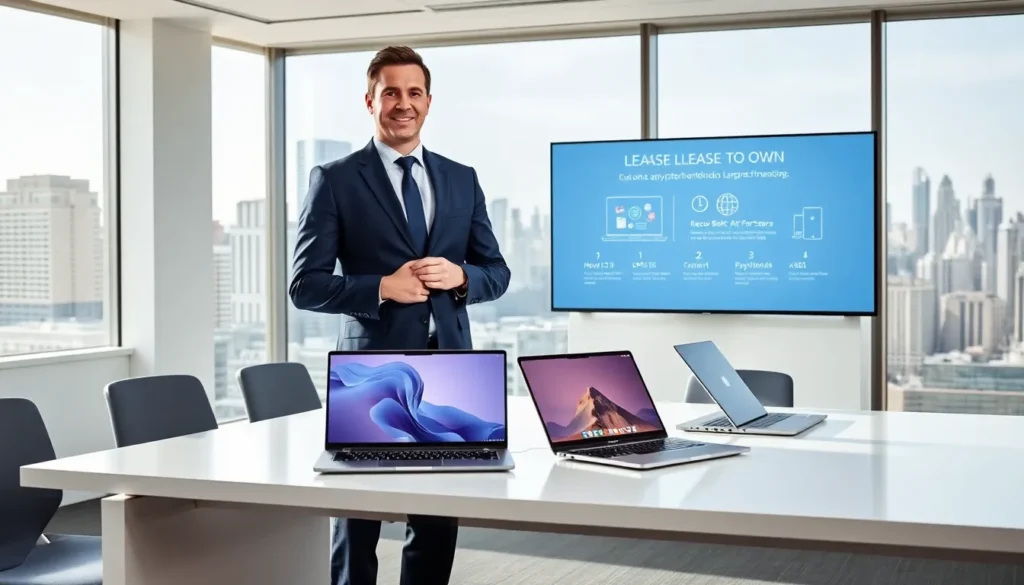Table of Contents
ToggleIn a world where technology advances faster than a cat on a hot tin roof, finding the right laptop can feel like searching for a needle in a haystack. Enter lease-to-own laptops, the superhero of the tech world saving your budget and your sanity at the same time. Imagine having the latest gadget without the financial kryptonite, that’s the magic of leasing. This guide will walk you through everything you need to know about lease-to-own laptops, ensuring you make a decision that even your wallet will thank you for.
What Is Lease To Own Financing?

Lease-to-own financing offers an alternative to traditional purchasing methods, providing customers opportunities they might otherwise miss. Instead of outright buying a laptop, individuals can lease it with the option to purchase it later. Think of it as a trial run, allowing users to test the tech before committing. This style of financing is often popular for those who prefer flexibility or may not have credit histories that support traditional loans. The appeal lies in being able to enjoy use of the laptop while paying gradually over time.
The process generally involves a set lease period, typically between one and three years, during which payments are made. At the end of this period, users can decide whether to buy the device outright or return it. Simple, right? But hold onto your hats: there’s more to this financing style than just basic payments.
Benefits of Leasing To Own Laptops
Leasing to own laptops comes with a suitcase full of benefits. One of the main advantages is the affordability factor. Instead of saving for months to buy a high-end laptop, individuals can enjoy a lower monthly payment that fits snugly into their budget. This accessibility means anyone can get their hands on the latest technology without very costly.
Another benefit is the time factor. Tech evolves quicker than anyone can keep up with, and leasing offers access to the latest models without being tied down. Users can upgrade after a set period without feeling the regret of being stuck with outdated tech.
Also, most lease agreements come with built-in warranties or maintenance options, meaning the stress of repairs falls off the user’s shoulders. This safety net often leads to less anxiety about potential malfunctions or damages.
How Lease To Own Laptops Work
Understanding the mechanics of lease-to-own laptops can clear up any lingering confusion. Typically, a customer browses available models at a retailer or distributor and selects a laptop of their choice. Next, they’ll sign a lease agreement that outlines the terms, including the length of the lease, monthly payment amounts, and any conditions for purchase after the lease ends.
Frequently, the agreement will note the amount needed to buy the laptop at the end of the lease, often called the purchase option price. Customers should carefully consider this figure as it can influence the overall cost of leasing.
Payments are usually monthly, and online payment options make managing them as easy as pie. In some cases, there may also be an option for early buyout, which allows users to purchase the laptop before the lease term ends, perfect for anyone who finds their leased laptop is now their tech soulmate.
Factors to Consider Before Leasing a Laptop
Before diving headfirst into lease-to-own agreements, it’s wise to consider several factors. First off, potential users should assess their personal budget. It’s crucial to ensure that monthly payments don’t cause financial strain. It might be tempting to lease an ultra-sleek laptop, but if the payments push budgets to the limit, it’s not the right choice.
Another factor is the intended use of the laptop. For example, a casual user may not need a high-performance gaming laptop, while graphic designers will require something more powerful. Understanding these personal needs ensures selecting the best laptop option that meets specific requirements.
Finally, users should read the fine print of lease agreements. Terms can vary significantly between providers, and understanding the lease’s end conditions and maintenance agreements are critical. It’s also beneficial to check the brand reputation of the leasing company for extra peace of mind.
Best Lease To Own Laptop Options in 2025
Now that lease-to-own laptop financing is clearer than a sunny day, let’s jump into some of the best options available for 2025. As technology progresses, several standout models have distinguished themselves in the lease-to-own market.
- Dell XPS 13: Renowned for its performance and sleek design, the Dell XPS 13 is perfect for professionals and students alike. With excellent battery life and a vibrant display, it’s a dream to lease.
- Apple MacBook Air M2: For Apple enthusiasts, the latest MacBook Air offers incredible processing capabilities. Its lightweight design makes it an ideal option for those on the go.
- HP Pavilion x360: This 2-in-1 model is great for those who enjoy versatility. Offering a touch screen and impressive graphics, it serves casual users and professionals well.
- Lenovo ThinkPad X1 Carbon: Favorable among business professionals, the ThinkPad X1 has a reputation for robustness and impressive battery life, making it a valuable asset to lease for work or personal use.
These options provide a fantastic blend of functionality, reliability, and style, catering to various needs and preferences.
Tips for Making the Most of Your Lease To Own Laptop
To maximize the lease-to-own experience, consider a few savvy tips. First and foremost, keeping the laptop in good condition will make a significant difference at the end of the lease. Treat it like a cherished pet, no bumpy rides or reckless handling.
Second, users should stay on top of warranty services and suggested maintenance, keeping everything sorted can prevent unexpected expenses. And while it might seem tempting to push the limits, pranks involving well-intentioned upgrades can derail warranties, so proceed with caution.
Finally, consider your options if the laptop isn’t meeting your expectations. Some companies allow users to swap out laptops for another model, always check if this is feasible, as it may save time and money.





